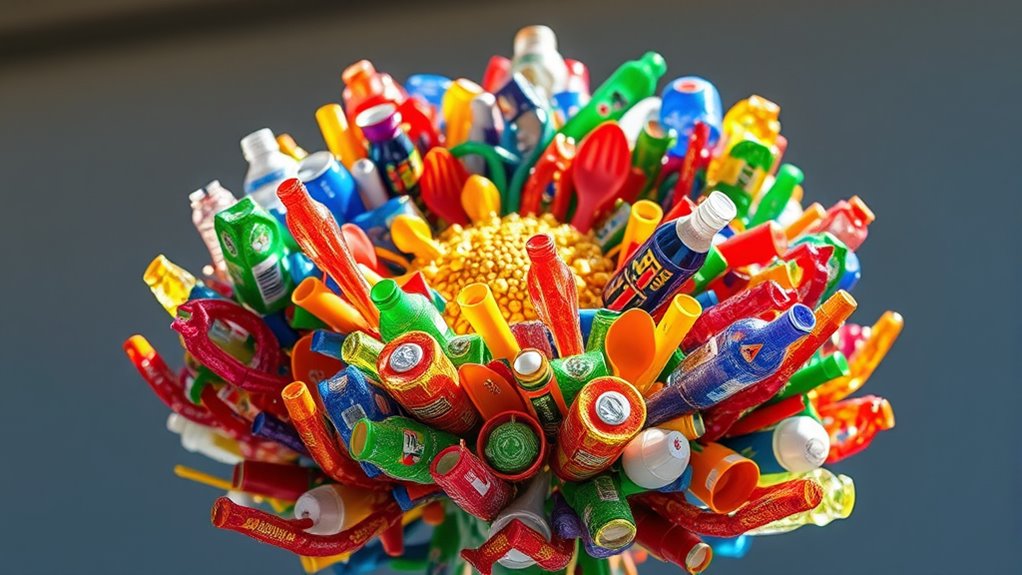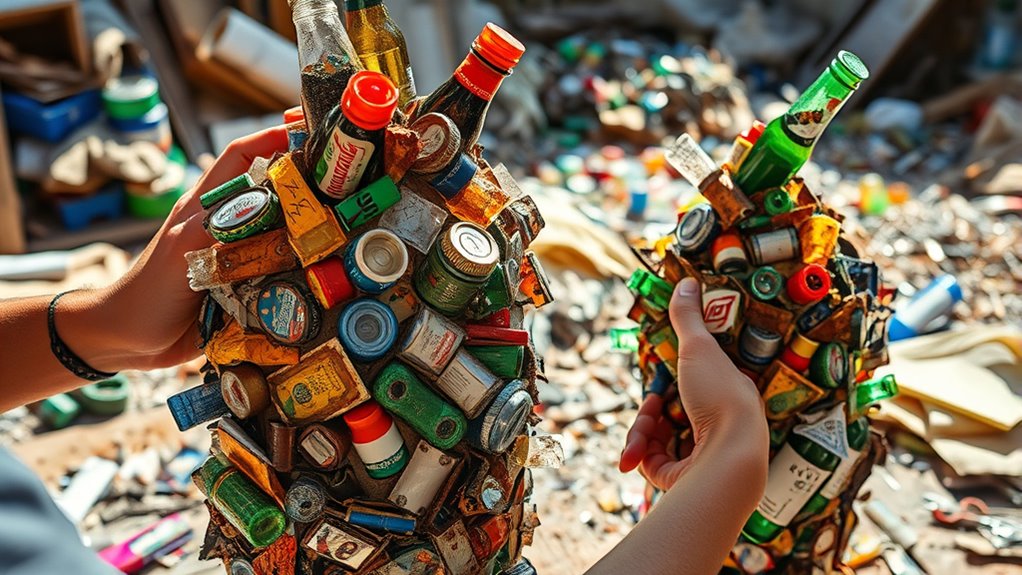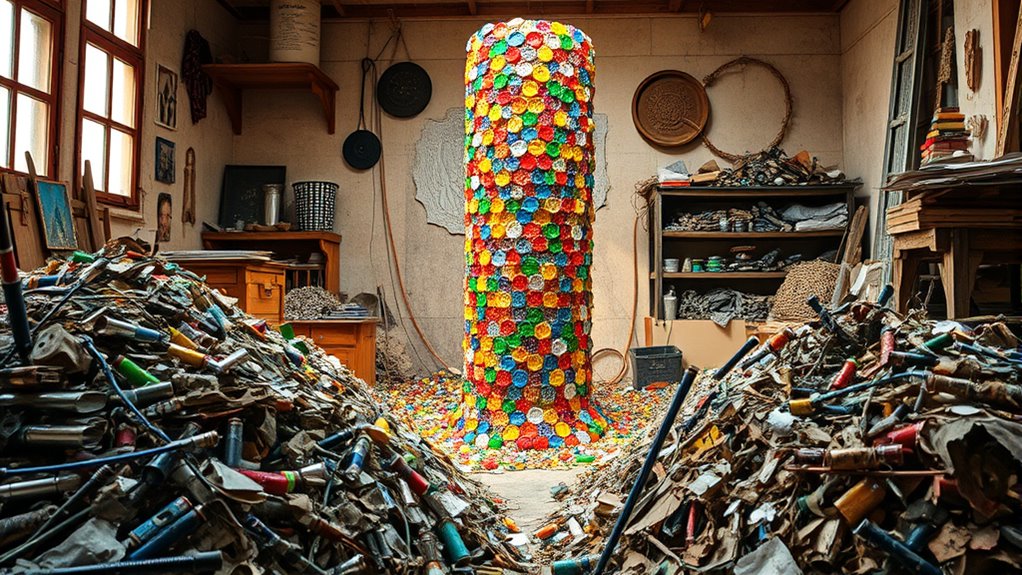Discover how artists transform waste into inspiring masterpieces by manipulating discarded materials like plastic bottles, cassette tapes, and textiles. They clean, shape, and arrange these objects to create meaningful symbols that reflect cultural values, environmental concerns, and societal stories. This process turns trash into powerful art that raises awareness and encourages change. If you want to uncover more about the creative techniques and impactful stories behind upcycled art, there’s plenty to explore ahead.
Key Takeaways
- Artists transform discarded materials like plastic bottles and cassette tapes into intricate artworks, highlighting environmental issues and cultural stories.
- Specialized techniques manipulate fragile recycled items, balancing aesthetic appeal with durability and symbolic meaning.
- Reclaimed objects are used to reflect cultural identity, preserve heritage, and evoke nostalgia through traditional crafts and symbols.
- Upcycled art raises awareness about waste pollution, encouraging sustainable practices and community engagement through impactful visual installations.
- Creative manipulation of diverse materials creates powerful narratives, turning trash into meaningful artifacts that inspire reflection and change.
The Artistic Journey of Erika Iris Simmons

Erika Iris Simmons began her artistic journey by transforming everyday discarded objects into intricate portraiture, capturing the attention of the art world with her innovative use of cassette tapes. She carefully unravels and weaves the tapes, creating detailed images of famous icons like Jimi Hendrix, Bob Dylan, and Madonna. Her process involves meticulous manipulation of the tapes to achieve realistic shading and depth. Simmons chooses cassette tapes because they symbolize a bygone era of music and cultural memory, adding layers of meaning to her work. Her art not only highlights creativity but also explores themes of nostalgia and consumerism. As you observe her portraits, you’ll appreciate how she turns something considered obsolete into a compelling visual narrative.
Transforming Plastic Waste Into Visual Masterpieces

You can see how artists turn plastic waste into stunning visual arrangements that captivate viewers. These creations not only showcase creativity but also raise awareness about environmental impacts. By transforming discarded plastics into art, they make a powerful statement about sustainability and consumer habits. Using upcycled materials like plastic waste in art can also highlight the importance of reducing reliance on single-use plastics.
Creative Plastic Arrangements
Transforming plastic waste into visual masterpieces showcases the artistic potential hidden within discarded materials. You can see this in how artists arrange plastic bottles, caps, and packaging into intricate sculptures, mosaics, and installations. By meticulously assembling these items, they create eye-catching displays that challenge perceptions of waste. For example, artists might cluster plastic lids to form vibrant portraits or use shredded plastic to craft textured backgrounds. These arrangements often highlight color, form, and pattern, making waste visually compelling. You’re encouraged to think differently about discarded plastics—seeing them not just as trash but as versatile art elements. This approach transforms pollution into meaningful, aesthetic expressions, inspiring viewers to reconsider waste and its role in both art and society. Float mounting textile art techniques can also be adapted to create layered, three-dimensional effects in mixed media art projects. Additionally, understanding the artistic potential of waste can open new avenues for sustainable creativity and environmental advocacy.
Environmental Impact Awareness
By turning plastic waste into striking visual art, artists draw attention to the urgent issue of environmental pollution. Their creations serve as powerful reminders of the damage caused by discarded plastics. You can see how they highlight key concerns, such as:
- Raising awareness about ocean pollution and the Pacific Garbage Patch
- Demonstrating the scale of waste accumulation through large installations
- Encouraging viewers to rethink consumer habits and reduce waste
- Inspiring community action and policy change for environmental protection
These artworks make pollution tangible, helping you understand its severity. They push you to contemplate your role in waste management and environmental sustainability. By showcasing trash as art, artists motivate change, making the invisible problem of waste visible and urgent.
Cultural Significance of Reclaimed Materials in Art

You can see how reclaimed materials reflect cultural identity by showcasing local traditions and history through art. These objects often symbolize deeper meanings, connecting communities to their heritage and values. By incorporating familiar items, artists preserve cultural narratives and give new life to shared symbols. Additionally, the symbolic significance of these materials can evoke emotional responses and foster a sense of community pride. Incorporating reclaimed materials also demonstrates a commitment to sustainability and environmental consciousness within artistic practices. Furthermore, understanding the cultural intelligence behind these choices enhances the authenticity and impact of the artwork. Recognizing the cost and budgeting involved in sourcing and repurposing materials can also influence the scope and scale of such projects, ensuring they are both impactful and feasible. Embracing innovative building techniques can further elevate the creative use of waste in art.
Cultural Identity Reflection
What does the choice of reclaimed materials reveal about a culture’s values and history? It shows what a community considers meaningful, whether it’s everyday objects or symbols of tradition. Reclaimed materials carry stories, embodying collective memory and identity. They reflect a culture’s relationship with consumption and waste, highlighting values like sustainability and resilience. When you see artists repurposing local debris, it’s a statement about cultural pride and adaptation. Additionally, the importance of color accuracy in visual arts emphasizes how precise and meaningful the presentation of these reclaimed materials can be. Recognizing the well-being impact of engaging with art can also deepen the connection between communities and their cultural expressions. Furthermore, understanding the cultural significance of materials can enhance appreciation for the depth behind artistic choices and their reflection of societal values. Moreover, the way materials are selected and transformed can reveal underlying cultural narratives, illustrating how history and identity are woven into artistic expression.
Material Symbolism Significance
Reclaimed materials in art carry powerful symbolic meanings that deepen their cultural significance. When you incorporate objects like cassette tapes, plastic bottles, or kitchen utensils, you’re not just repurposing waste—you’re embedding stories and values into your work. These materials often symbolize consumerism, environmental neglect, or cultural identity, challenging viewers to reconsider their relationship with waste. For example, a skull made from metal utensils can represent India’s rapid economic growth and shifting societal priorities. Using familiar items connects audiences emotionally and highlights themes of sustainability and cultural change. Moreover, the cultural symbolism of reclaimed materials can evoke a sense of continuity and tradition, linking past and present through art. Your choice of materials transforms discarded objects into symbols that provoke reflection, making the artwork a commentary on societal values and environmental issues. Additionally, vertical storage solutions can help organize and display reclaimed art pieces effectively, emphasizing their cultural significance and encouraging mindful appreciation of recycled materials. Incorporating artistic techniques, such as layering and texture, can further enhance the narrative and emotional impact of reclaimed art, making it more engaging and meaningful. Employing sustainable practices in the creation process also underscores the importance of eco-friendly art in promoting environmental awareness. Integrating cultural narratives can deepen the viewer’s understanding and connection to the artwork’s message. This symbolism elevates everyday trash into meaningful artifacts of cultural commentary.
Heritage Preservation Through Art
Heritage preservation through art leverages reclaimed materials to maintain cultural identity and transmit traditions. By repurposing objects rooted in history or daily life, artists connect communities to their roots. You can see this in works that incorporate traditional crafts or locally significant items, preserving stories and customs. Additionally, the use of vintage textiles or tools can evoke a sense of nostalgia and continuity within communities. Incorporating rustic decor elements further emphasizes the connection between the artwork and rural or historical settings. Using dollar-cost averaging techniques can also help artists manage financial risks associated with sourcing and creating with reclaimed materials, ensuring sustainable practices. Reclaimed artifacts highlight cultural evolution and resilience. Artists embed symbols that reflect shared history and values. Materials like vintage textiles or tools evoke collective memory. Artworks serve as dialogue between past and present, fostering identity continuity. Embracing creative practice allows artists to develop innovative ways to incorporate reclaimed materials into meaningful art forms. Additionally, integrating sustainable materials promotes environmentally conscious art creation. Through these creations, you preserve intangible heritage, giving new life to discarded objects and ensuring cultural stories endure. This approach transforms waste into meaningful symbols that celebrate community, history, and cultural pride.
The Impact of Recycled Art on Public Awareness

Recycled art plays a powerful role in raising public awareness about environmental issues and sustainability. When you see these artworks, you’re reminded of the waste we produce and the potential to repurpose it creatively. Artists like Erika Iris Simmons and Messy Msxi use familiar discarded objects to craft impactful visuals, making you pause and reflect. These pieces turn trash into compelling stories about consumerism, pollution, and ecological responsibility. By showcasing recycled art in galleries and public spaces, you’re exposed to tangible examples of how waste can become meaningful, beautiful, and thought-provoking. This visibility encourages you to reconsider your consumption habits and supports a shift toward more sustainable choices. Incorporating visualization techniques can help reinforce the importance of sustainability in your daily life, inspiring you to adopt more eco-friendly habits. Highlighting environmental impact through these artworks demonstrates the urgent need for responsible waste management and recycling efforts, inspiring greater community engagement. Additionally, public engagement with recycled art fosters a deeper understanding of ecological issues and motivates collective action. Ultimately, recycled art sparks conversations and inspires action to protect our environment.
Techniques and Challenges in Upcycled Art Creation

Creating upcycled art involves a range of techniques that artists develop to transform discarded materials into compelling works. You might unravel cassette tapes to weave detailed portraits or shred plastic bottles to create textured mosaics. Precision is key when cutting, shaping, or arranging materials, often requiring specialized tools. Challenges include ensuring durability, as recycled items may be fragile or unstable. Artists must also clean and prep materials to remove dirt, labels, or contaminants. Balancing aesthetics with environmental messages is essential, as the choice of materials influences the piece’s meaning.
- Manipulating fragile or irregular materials without breaking them
- Securing non-traditional materials with adhesives or fasteners
- Achieving visual cohesion from diverse textures and colors
- Overcoming limitations of recycled materials’ structural integrity
Inspiring Change Through Artistic Expression

Art has the power to challenge perceptions and inspire action, especially when it transforms waste into meaningful messages. When you see discarded materials turned into compelling artwork, you realize how creativity can drive social change. Artists use their work to raise awareness about environmental issues like pollution and overconsumption, prompting viewers to reconsider their habits. Through powerful visuals and thought-provoking concepts, these artists inspire individuals and communities to adopt more sustainable practices. Their art becomes a catalyst for dialogue, encouraging people to see waste not as trash but as potential. By engaging audiences emotionally and intellectually, this artistic expression motivates change beyond galleries, fostering a collective push toward environmental responsibility and cultural reflection. Your perspective shifts, realizing that art can be a crucial tool for activism and transformation.
Frequently Asked Questions
How Does an Artist Select Materials for Upcycled Art Projects?
You select materials for upcycled art projects based on availability, cultural significance, and environmental impact. Think about what’s accessible around you, like discarded objects or recycled items, and consider their meaning or message. Use materials that resonate with your theme or story, whether it’s consumerism, sustainability, or cultural identity. Your choices should inspire your creativity and help convey your message effectively, turning waste into compelling, meaningful artwork.
What Environmental Benefits Does Recycled Art Provide?
You might find it surprising that recycling art can reduce landfill waste by up to 80%. When you create with discarded materials, you cut down on pollution, conserve natural resources, and lower energy consumption involved in producing new items. Recycled art also raises awareness about environmental issues, inspiring others to adopt sustainable practices. By turning waste into art, you help fight pollution while promoting eco-friendly living and fostering a more sustainable future.
How Do Artists Ensure the Durability of Trash-Based Artworks?
You can guarantee the durability of trash-based artworks by selecting sturdy materials like scrap metal, glass, or thick plastics that withstand environmental conditions. You should also use strong adhesives, welds, or sealing techniques to secure parts firmly. Applying protective coatings, such as varnish or resin, helps resist moisture and wear. Additionally, proper preparation and maintenance are key to preserving the piece’s integrity over time, ensuring your art remains impactful and lasting.
Can Recycled Art Influence Consumer Habits and Attitudes?
Recycled art can definitely influence your consumer habits and attitudes. When you see artworks made from trash, it raises awareness about waste and environmental impact. It encourages you to think twice about your consumption, promoting sustainability. By engaging with these pieces, you might start choosing reusable items or reducing waste. Art has the power to inspire change in your mindset, making you more mindful of your choices and their effect on the planet.
What Skills Are Essential for Creating Detailed Upcycled Artworks?
You need patience and precision to create detailed upcycled artworks. Develop strong craftsmanship skills like cutting, weaving, and assembling materials carefully. Creativity helps you see potential in discarded items, while an eye for detail ensures your work is intricate and accurate. Practice experimenting with different textures and techniques. Good planning and organization are essential to manage materials efficiently. Ultimately, stay open to innovation and be willing to learn new methods to refine your skills.
Conclusion
You see, by turning trash into art, Simmons reminds us that one person’s waste can become someone’s wonder. Her work proves that “one man’s trash is another man’s treasure,” inspiring you to reconsider how you view discarded materials. Through creativity and resilience, you can transform the overlooked into the extraordinary, sparking change and fostering awareness. In the end, it’s your actions—no matter how small—that can help turn waste into a meaningful, lasting legacy.




